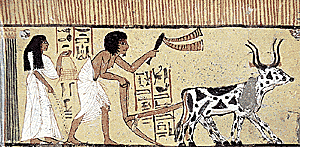Agriculture & Farming in Ancient Egypt
Agriculture & Farmers
The life of a farmer was extremely hard, he was a tenant of the king who answered to the kings Nomarchs/lord for the payment of taxes each year. The two types of crops the Egyptians grew were Emmer Wheat and Barley, for food production. The Egyptians also grew flax for yarn to produce linen. The agricultural calendar consisted of three seasons, Akhet (flood) Peret (season of sowing) Shemu (Harvest time), each season consisted of four months of thirty days, the season of Akhet started with the appearance of the dog star in July. During Akhet the farmer would start rebuilding his canals, dykes and tributies for the channelling of the floodwaters on to his patch of land. Close co-operation must have been needed with neighbouring farmers to complete these tasks and for the success of the Nile silt to be evenly deposited during the flood. Without the flood no silt would be available for farming, food production would be halted and famine would come into the land. Therefore it was vital to get organised and be prepared for the flood. Once the flood had receded back into the banks of the Nile the farmer could sow prepare the land.
Poor farmers used a hand tool to break the large clumps of silt, rich land owners would employ servants to do this with a plough and oxen. Once the land was prepared the seeds were sown by scattering the seeds directly on to the Nile silt, then cattle were driven over the seeds to stamp the seeds into the Silt, once completed the farmer waited for his crops to grow. The two main crops were Emmer Wheat and Barley.
From wheat bread was produced in the small clay ovens of the day, fuel from brush wood and animal dung, the Egyptians did not have access to crude oil, gas or coal for fuel so bundles of brush wood could be considered as a commodity. Because Egypt is a dessert county wood was a valuable resource mainly used as a precious material for building expensive boats and coffins.
Access to tree felling would be strictly prohibited resulting in the small size of the ovens built to bake the bread. Once the bread was produced beer production could commence. Beer was regarded, as a foodstuff rather than an alcoholic beverage however, there are several recipes, which have survived from tomb discoveries, which include high alcohol content in beers, which were consumed at parties and festivals. Every person in Egypt consumed bread & beer as part of there staple diet it didn’t matter if you were two years of age or sixty everyone would drink the beer.
In kings Seti I offerings list the first two commodities at the top of the his list were bread & beer for the afterlife, even though as a king/god he could have an abundance of offerings, such as wine and lotus flowers, Seti decided that these were the two most important making the more exotic food stuffs second. Another possible reason as to why the Egyptians allowed their children to consume beer were the hazards of collecting fresh water.
The Nile in ancient times had many hazards, a fast flowing current, crocodiles, hippopotami and poisonous water snakes, which if the Egyptians encountered could prove fatal. Men are recorded in scenic relief’s completing washing tasks of clothing because the dangers to woman were too high. The other advantages of brewing beer were the large stocks which could be assembled for each family next to there house, with the introduction of alcohol during the fermentation process the beer was a fresh liquid commodity reducing the hazards of collecting fresh water from the Nile. The added bonus of the alcohol content in beer would help fight off infection during the passing of beer through the gut and stomach of the ancient Egyptians. Rather than consuming a heavy evening meal as we do today, remembering Egypt is a very hot country it was a custom of most families to have five snakes a day, again reducing the risk of infection from bacteria as the foodstuffs passed through the body. Bread & beer was supplemented with salads such as cucumber, radishes, cos lattice, raw onions, dates from the date palm tree, figs, fish and a little meat. Again because Egypt is a dessert country the grazing of cattle was limited to the Delta regions of Lower Egypt reducing the animal husbandry of rearing cattle. Even today meat is an expensive commodity only consumed at special occasions.


